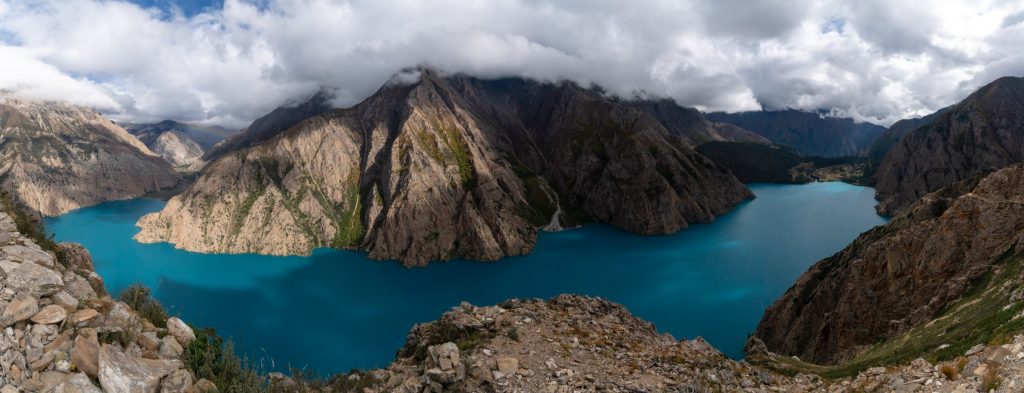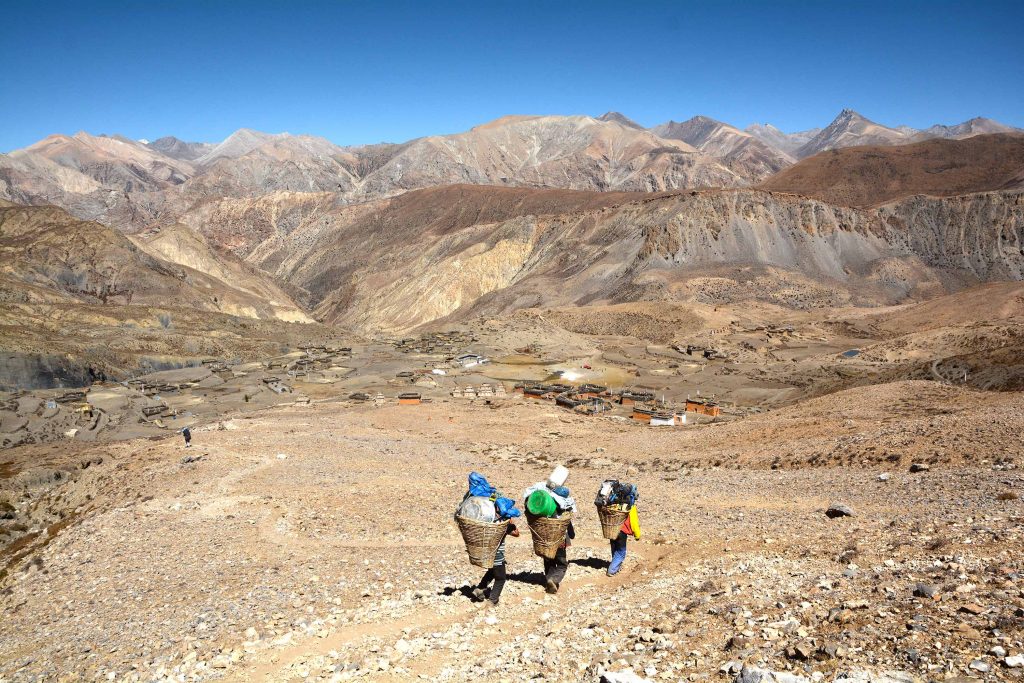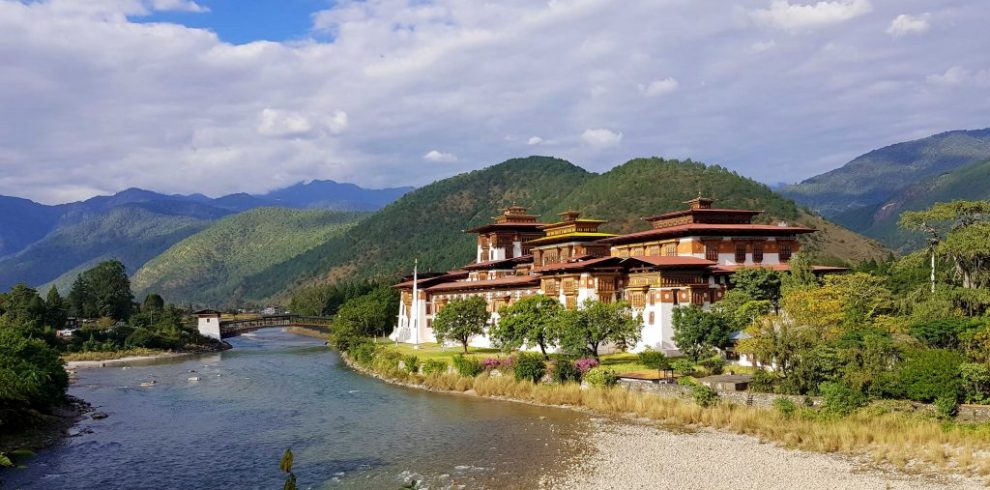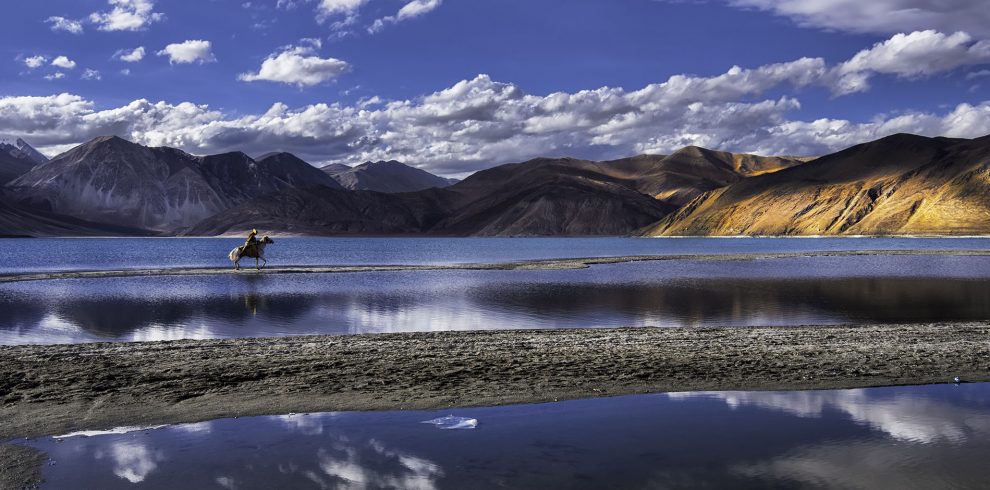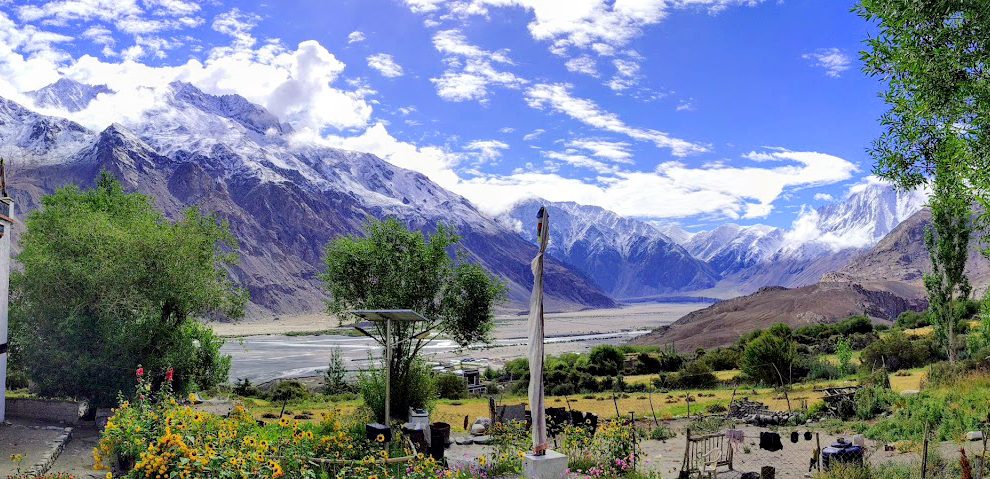Dolpo lies in the far west region of Nepal and is one of the most remote regions in the Himalaya. The name Dolpo comes from Dolpa. The unforgivably rugged terrain of Dolpo in mid-western Nepal is where the Himalaya still holds its own, beyond human intervention. The Dolpali are regarded as the original inhabitants of Dolpo region. The rough stone houses of Dolpo are all clustered into a narrow space, making the villages look like forts. The terrain is rather bare, with almost treeless grassland valleys, which take on a colourful luster in July and August with a carpet of bright alpine flowers of the Dolpo region.
Overview
Lower Dolpo trek offers excellent opportunities to visit ancient villages, high passes, beautiful Lakes, isolated Buddhist monasteries and also to experience the vast array of wildlife inhabiting the region.
This adventure begins with visits to the UNESCO World Heritage Sites in Kathmandu. Next, we fly to Jhupal via Nepalgunj and begin our trek through remote locations admiring the beautiful rain shadow landscape of the Himalayas,reflected in the colorful barren slopes of the mountains where the play of light and shadow is a perpetual fascinating spectacle.
Dolpo still remains one of the isolated corner, even though, for centuries people from Tibetan origin have continued to live, cultivate and do trade with Tibet and the different part of the country as well as with India. Moreover, there are several other monasteries that preserve the primitive culture and traditions and have the original texts.
This is also one of the few areas where the pre-Buddhist, Bon Po religion is still practiced. While on the trek, we get to muse at the yak caravans that maintain the traditional salt trade with Tibet. We also cross two high passes-NumaLa and BagaLa-and reflect on life amidst the tranquil waters of Phoksundo Lake.
Itinerary
Once you reach KTM airport and finish with the immigration and custom formalities be prepared to confront the confusion outside the airport which is common in most of the south Asian countries. As you walk out of the Exit door into the passenger pick up area you will see hundreds of people with different sign boards in their hands, taxi drivers looking for fares, hotel touts looking for customers and porters trying to help with the luggage for tips. Please remain calm and do not walk out of the restricted area into the crowd straight away. Remain there and try to find the Hi On Life’s sign board. Once you spot it, walk straight to the signboard and identify yourself. From here we will take care of you.
When you arrive to your hotel you will be briefed about your activities and “do’s and don’ts” while your stay in Kathmandu. We will also collect some documents from you. Please have the following things handy when arriving.
Travel/ Medical Insurance (photo copy)
3 passport size photos
Original passport.
In the evening we will go for a traditional Nepali dinner at Kathmandu’s finest Nepali restaurant to end the day.
After breakfast you will be taken for a half day city tour where you will be visiting some historical temples and monuments.
Places you will visit:
Boudhanath Stupa: It is the largest stupa in Nepal and the holiest Tibetan Buddhist temple outside Tibet.
Kathmandu Durbar Square: Commonly called Basantapur Darbar is one of three Durbar (royal palace) Squares in the Kathmandu Valley in Nepal, all of which are UNESCO World Heritage Sites.
Durbar Square was surrounded with spectacular architecture that showed the skills of the Newar artists and craftsmen over several centuries, but several buildings in the Square collapsed due to a major earthquake on 25 April 2015.
You will end your sightseeing with a lunch. After your lunch your group leader will give you your trek briefing and issue you your ‘trek pack’ consisting of a duffle bag, down jacket, sleeping bag, inner liner for your sleeping bag and rain poncho. Your afternoon is free for you to do your packing and purchasing your last minute items for your expedition.
Flight: 1 hour
From Kathmandu airport we fly to Nepalgunj which should take about an hour. Nepalgunj is a on the Terai plains near the southern border with India. It is an important junction to connect all of Western Nepal, being the gateway to far West mountainous regions like Dolpo and Jumla and also to Bardia National park which is famous for Jungle Safari tours to see tigers.
Upon arrival to Nepalgunj, we will check in to our hotel. You can expect a temperature bet 32C to 38C. There is a swimming pool at the hotel, therefore do not forget to bring your swimming contume to chill out at the pool.
Overnight hotel
Flight: 40 mins
Drive: 1 ½ hours
Early morning flight in a small twin otter plane will take us to Juphal which is a small airport that connects the region of Dolpo with rest of Nepal. Once we land at Dolpo we will be asked to make entries of our passports since this is a restricted area. We will walk past the airport and the village and take a jeep to Dunai. The road descends and winds through local villages down to Kalagauda, where there are some shops and tea houses. We drive along the riverside and pass through Roop Ghar a small cluster of houses with a water mill and finally reach Dunai bazar.
Here,we meet our trekking staff and begin the adventure.
Overnight hotel.
Dunai is a small bustling town which is former Village Development Committee that is now part of Thuli Bheri Municipality in Nepal. Dunai is also the district headquarters of Dolpa District. This small town have private and government schools and colleges, police check post and some government offices.
Trek- 7 hours
As the trek begins today, we follow the upstream trail that banks Bheri River. First part of today’s trek is very pleasant as we trek along the leveled path occupied by beautiful landscapes in the neighborhood. Almost a couple of hours of trek bring us to the settlement of Byasghar 2430 m. Exiting out of Byasghar, we continue trekking along the riverside trail that heads towards northeast direction. During this part of the trek, the trail most of the time flanks the river closely and at other times it climbs over the hill or around the ridge. The trek continues along open trails before it arrives to Baijibara. This small settlement holds a Bon Monastery. Further after a short uphill trek, dry stone walls and cultivating fields indicate the arrival of famous mid-hill settlement of western Nepal, Tarakot. A small settlement that nestles high above Thuli Bheri River, was once a famous trading point as it was the capital of ancient independent kingdom Tichorung. Most of the natives of the village belong to Magar tribe and most of them practice Tibetan Buddhism as their religion. In some clusters of ‘Kaike’ a local dialect is spoken, which is not spoken anywhere else.
Trek- 5 hours
As the trek begins today, we hike along the trail that lies on the southern bank of Bheri River. An hour long trek brings us to the open valley created by Bharbung Khola. This part of the trek brings us closer to Putha Huinchuli and Churen Himal. The trail beyond Bharbang Khola chases the easy steps that eventually brings us to Laisicap 2775 m. Now, we cross the main river and begin to trek along the west bank of Tarap Khola. We head north until we arrive to Khanigaon 2950m. Khanigaon is the winter residence of the Dho-Tarap people. We can see the wonderful view of Sandul Gompa across the valley from Khanigaon. The Gompa lies at a juncture between Barbung Khola and Tarap Chu river. The final push on the steep uphill trail finally brings us to Laini Odar, which is a wonderful camping site with a beautiful waterfall nearby.
Trek- 6 hours
As we head further from Laini Odar, the trail goes through the deep gorges with scary cliffs above them. The walk is quite exciting as the valley becomes a narrow gorge that in some places you can jump from one side to another. After a couple of hours of trek to the north from Laini Odar, the trail begins to become relatively open. A little bit of effort put to make the trail easier can be seen. We now trek on the easy trail paved with wooden planks and flat stones that leads us to Chhyugar 3440m. Chhyugar lies at the bank of a small stream which we cross and begin to trek along its western bank to Pibke or Nawarpani 3475m. The final part of today’s trek, which lasts for a couple of hours brings us to Toltol 3530m. Toltol is a winter refuge for the people of Upper Dolpo. We will settle down our camps here for the overnight stay.
Trek- 7 hours
One of the most interesting days of the trek is about to begin. We begin today’s trek by gradually ascending to Kamattarka at the confluence of the Tarap Chu and Lang Khola. The trek most of the time runs along the bank of Tarap Khola switching sides frequently. In the first part of the trek we hike along the northwest bank of Tarap Khola to Ghyamghar, a small settlement with a monastery. After walking for several more hours, we reach the village of Dho Tarap which is surrounded by a stone wall, the last part of today’s Inner Dolpo Trek slides down from this small hill to Dho Tarap 3950m. Dho Tarap is a fascinating settlement that manifests the real attributes of Dolpo. This famous settlement of Dolpo nestles high above a wide valley and was a famous trading point to the traders of Tibet and Mustang in the ancient days. In this Valley both BonPo and Chaiba religious sects reside together. Tarap is also inhabited by a few Tibetans and mostly Magars who have lived here for many generations.
Dolpo is a treasure trove. Barren landscapes and tough living conditions that still spins around horses, mules and yak, Dolpo is the home to many time forgotten villages nestling at the foothills of Himalayan giants.
One out of few villages, Dho Tarap is recognized as village we hear in the stories we all would love to experience, amazing landscapes and the hamlets practicing most unique Tibetan culture dating back to ancient times are the prime highlights of Dho Tarap. Dho Tarap, the highest altitude of human settlement or one of the highest altitude hamlets in the world settling at 4080m is a spectacular village that encounters to the trekkers who are willing to trek the high altitude regions of Dolpo. Flanking villages Dho and Tarap are collectively known as Dho Tarap. We can spend the day visiting nearby monasteries. During today’s short walks,we also get a chance to get acquainted with the local culture. Both men and women often wear religious amulets and strings of coral,amber and turquoise. The people of the region are both BonPo and Nyingmapa (Buddhist sects).
Trek- 7 hours
After spending a day at Tarap, we resume our trek the next day. On the way, we also happen to cross the ‘Crystal Mountain School’ which educates the children from the nearby region. We will trek towards the upper Tarap valley enjoying views of lush grasslands on both sides of the river which is
unique to this part of the inner Dolpo and walk alongside Tarap Chu river and take pleasure in the amazing views of the vast Tarap valley with its wide plains and high mountains. A few hours' good walk takes us to the village of Tokyu which houses a Buddhist monastery of the Chiba sect. After exploring the monastery, we will continue walking up the valley on a rough trail before reaching the Numa La Base Camp. Overnight in Numa La Base Camp.
Trek- 7 hours
Crossing the first 5000m pass of a trek is always tough but the view from the top is rewarding. It is better to start early so that we can cross the Pass before the weather deteriorates in the afternoon. Morning time is generally favorable to cross the Pass as it is easier and safer. This is blue sheep and snow leopard country. Today is going to be the toughest and one of the longest days of our trek. After breakfast, we will begin crossing the Numa La pass on a steep trail all the way up the top ridge of the pass. From the ridge we will get incredible views of the barren mountains of Dolpo up to Mt. Dhaulagiri (8167m).
On a clear day, it is possible to view Dhaulagiri, Annapurna, Manaslu and Kanjirowa (6883 m) mountains from the Pass. After getting to the top of Numa La, we descend to camp at Pelung Tang.
Trek- 6 hours
After breakfast we begin our steep climb up to the top of Baga La pass. From here, we get fantastic views of the dry landscape and the distant snow-capped mountains including Mt. Kanjirowa. We spend some time at the top of the pass taking pictures and enjoy the mesmerizing views. Next, we descend to Dajok Tang for an overnight stay.
Trek- 4 hours
We will spend most of today’s trek on trails alongside beautiful pine forests and alpine vegetation. We walk past Yak Kharka and Maduwa Khola and the path is beautifully carved out from the rocks. Then we cross a thick Pine forest and on the way we also see several beautiful waterfalls. After trekking for a short while on an easy trail with only gradual highs and lows, we will reach Ringmo Village. The village is a traditional Tibetan village of the Dolpo region. Along the trail from the high ridge we get our first glimpse of the lake. Here we also find one of the highest waterfalls in Nepal. The trail then descends through birch forests to the pretty village of Ringmo on the edge of Phoksundo Lake.
Ringmo is a traditional village in Dolpo in the Dolpo District of Nepal, with a seasonal population of about 200. The people are mostly of Tibetan ethnicity, and are of the Bonpo faith. Bonpo is related to Buddhism, but it is a lot older than Buddhism and goes back thousands of years. The religion was founded more than 18,000 years ago by Buddha Tonpa Shenrab Miwo. It is believed that Dolpa used to be the centre of the Bon kingdom, called Zhang Zhung, a big and powerful kingdom in present Western and Northwestern Tibet and surroundings, as in Dolpa you can still find a big concentration of Bonpo practioners. In the 7th Century, Zhang Zhung was defeated by the Buddhist kingdom of Tibet, and Bonpo disappeared almost completely. However many Bon traditions were absorbed into Tibetan culture. It has more animistic aspects than Buddhism. For outsiders it is difficult to see the difference between Bonpo and Buddhism, hence one small but important detail is that you have to cross their shrines, like mani walls and chortens anti clockwise, while according to Buddhist custom, you pass them clockwise.
Ringmo lies at the shore of the holy Phoksundo Lake. This lake is of a stunning beauty. It has an enchanting deep blue color and is emerald green close to the shore. The water is crystal clear, with no aquatic life in it. Steep cliffs and snowcapped mountains surround the lake. The colors change a bit during the day; you just won’t get enough of simply looking at it. Hike to Phoksundo Lake, today we explore the great Phoksundo Lake and camp at its shores. We see yak caravans moving in and out of Ringmo mostly towards Tibet and orders on remote mountain trails. The scene even depicted in a Hollywood movie ‘Caravan’ was shot mostly in this location. On our way to the lake, we also tour a nearby monastery. After reaching the Phoksundo Lake, we can enjoy a relaxing walk on the serene lake’s shores.
Trek- 6 hours
Today we will trek downhill to Chepka. From Chepka the trail follows a massive overhanging rock. During our trek, we will find many important medicinal minerals in this area which are believed to cure almost anything. The route then passes through villages, before climbing to Shyanta. Overnight in Shyanta.
Trek- 5 hours
We will march towards Jhupal via Sulighat on a trail surrounded by birch trees. From atop a ridge, we can get the most spectacular views of the mountain above us and Jhupal Village below. However, utmost caution is required while trekking along this trail. Finally the valley widens up after Sulighat and the trek heads towards Dunai by the bank of Bheri river. The trail follows Bheri river and there is a final climb of around an hour to reach Juphal, the ending point of the trek. After reaching Jhupal, we can spend our afternoon exploring the busy market town or simply taking some rest.
We take the earliest flight from Jhupal to Nepalgunj. After reaching Nepalgunj, we return to Kathmandu on the next available flight.
Price Includes
- 4 nights hotel in KTM on B/B – Twin Sharing Room
- 1 night hotel in Nepalgunj including all meals.
- Restricted area permit
- National Park fee, TIMS permit fees
- Flight: Ktm-Nepalgunj & Nepalgunj-Juphal.
- Flight back: Juphal-Nepalgunj-Kathmandu.
- Services of English speaking guide.
- Cook and kitchen helpers, assistant guide and Sherpas
- Horses and mules for carrying bags and camping gears
- Full board camping trek
- Comfortable North face VE 25 tents on twin share basis unless single supplement is booked
- 1 ridge mattress + 1 high density foam mattress
- Kitchen tent, Dining tent with tables and chairs, and ShowerToilet tent
- All meals (B,L,D) during trek
- Hot beverages with biscuits and snacks on arrival to camp
- Use of personal trekking pack consisting of a duffle bag, sleeping bag, sleeping bag liners, and down jacket.
- Hi On Life Adventures T shirt.
- All Nepali staffs Insurance/ wages and equipment allowance
Price Excludes
- Insurance: Travel/Accident/Medical /emergency evacuation
- Private room accommodation in Kathmandu unless a single supplement is paid.
- Staff tipping
- Nepal entry Visa
- Telephone, laundry, mineral water, soft drinks and alcoholic beverages.
- Emergency rescue evacuation cost if needed
- All other personal nature expenses.
A Day on Your Trek
Although each day is different, considering the weather, general pace of the group and length of the days walk, in general your day begins with a wake up tea at around 6 to 6:30 in the morning. You will then be provided with a bowl of warm water for washing. Then you will need to pack your duffel bag and your daypack and come to the lodge’s diner for breakfast.
After breakfast we will hit the trail and usually walk for about 3 to 4 hours before we stop for lunch. We will give you about an hour and a half rest during lunch, which will also give enough time for the staff to have their lunch and pack. Usually after 3 to 4 hours of walking we finish the days walk by 4 PM. Tea/ Coffee and snacks will be served on arrival to the lodge. Your group Leader will often organize side trips in the afternoon. Your dinner will be served around 7 PM.
High Altitude
On this trek you will be going up to 5300m, so it is very important to understand the affects of altitude. The greatest provocation is going too high too fast. Hi On Life’s itinerary has been carefully designed to minimize the effects of altitude. We ascend slowly and surely allowing enough time for safe acclimatization.
Headaches and breathlessness are common at altitude which in itself is nothing to worry about. In rare cases, this may worsen to Acute Mountain sickness (AMS), so a close watch is kept on all trekkers by the group leader who is trained to recognize the symptoms of AMS which are severe headaches, nausea, lethargy, loss of appetite serious breathlessness even at rest. If any trekkers show such signs they will be descended to relatively lower and safer altitude. The Group Leader’s decision on evacuating such person to a safe altitude is final. Do not medicate yourself without first informing your group leader. Going to altitude slowly with adequate rest and adequate intake of fluid (3 to 4 litres per day), you will most likely have no problems apart from breathlessness on hills which is completely normal as the percentage of Oxygen in the air is relatively lower to that at sea level. The most important thing is not to worry about altitude because our team is there to take care of you.
Staff
Group leader: Our Group leaders are highly trained in all aspects of the trek, conservation, first aid specializing on altitude sickness, emergency procedures and have extensive knowledge of the natural history of the area.
Sirdar: His job is to manage and organize staff duties. He is responsible for the actual operation of the trek.
Cook: Responsible for your food. Hygiene of a high standard is taken into consideration in preparing the food.
Porters: They are responsible to transport kitchen equipment. Our porters are provided with Gore-Tex suits, trekking boots, gloves, hats, socks, snow gaiters and snow goggles. Most importantly, we regulate them on a 25 Kg carrying which no other company does.
Mules and yaks: To transport your duffel bags, tents and other camping facilities.
Weather:
June till September
On the trek at lower altitude (2500m to 3500m) during daytime the Max temp can be around 15C to 20C and the Min temp can be 5C to 10C
At higher altitude (3500m to 5000m) the daytime Max temp can be between 5C to 10C and Min temp can be between -8C to OC
Please note: when there is an overcast sky, the day time temperature can get down to -2C during day time at altitudes above 4500m. Also the wind makes a big difference in the real feel of temperature.
This is just general information and it could vary.
Recommendations for things you should bring:
Clothing:
Head:
- Warm hat wool or synthetic that covers your ears
- Sunhat
- UV shield/ Category 2 sunglasses
- Headlamp with extra batteries
- Bandana or head scarf, also useful for dusty conditions
- 2 polypropylene or wool mix t-shirts
- 2 polypropylene or wool mix long sleeve t-shirts
- 2 long sleeve thermal underwear shirts, lightweight preferably woolen
- 1 polar fleece pullovers medium weight
- 1 polar fleece jacket, OR Primaloft/ Down light weight jacket
- Gore-Tex jacket with hood, waterproof and breathable
- For high altitude use, 1 very warm goose-down jacket with hood (we provide this)
Hands:
- 1 pair medium weight wind stopper gloves
- 1 pr. lightweight poly-liner gloves
Lower Body:
- 1 pair walking shorts
- 1 to 2 pair walking trousers for trekking
- 1 pair stretchable running trouser for evening wear at lodges
- 2 pair lightweight thermal bottoms
- 1 pair Gore-Tex trousers, wind stopper
Feet:
1 pair trekking /walking boots with good ankle support
1 pair trainers, running shoes and/or sandals for Kathmandu and in lodges;
2 pair med weight preferably wool socks
2 to 3 pair of liner socks. Polypropylene or wool
2 pair lightweight trekking socks, poly or wool
Sleeping:
We provide:
- 1 down sleeping bag (rated to – 20 Centigrade or -0 F )
- 1 polar fleece liner
Rucksack and Travel Bags:
- 1 medium rucksack (30-35 litres)
- We provide you 1 big duffle bags.
- Small padlocks for duffel kit bags.
Assesories:
- 1 small roll of repair tape, 1 sewing repair kit
- Camera
- Nylon stuff sacks for food and gear storage, large Ziplocs are useful also
- 2 Water bottles (1 litre)
- 1 small folding knife
- Books, playing cards, ipod/mp3 player, games, small musical intruments
- Adequate amount of batteries, etc.
Health and trouble free holiday
There are no compulsory vaccinations required for entering Nepal. However please consult a doctor for vaccination against Typhoid, Meningitis, polio, and hepatitis. If you have special dietary requirements or allergies, please through your agent, give us a list of what you can and can’t eat so that we can provide proper food for you.
If you are undergoing a course of prescription medicine, please ensure that you have sufficient supplies for the entire holiday. Some types of drugs including anti malarial have side effects at high altitude; therefore please consult your doctors regarding these drugs. The places you trek are mosquito free and there has been no report on malaria in Kathmandu for the past couple of decades.
Insure yourself
We highly recommend you to take a comprehensive Personal Travel Insurance before leaving home. This should cover for your loss of baggage, airline delays, sickness and accidents. And it should also cover you for Emergency Helicopter Evacuation.
Money Matters
The ideal currency to bring with you is USD.
In Kathmandu: Each meal will cost around 4 to 6 USD. Plus 10 to 20 USD for your taxis if you wish to go around the city.
On trek: You will need around 6 to 8 USD per day. This money is for your hot showers, chocolates, soft drinks and beers etc and also for small donations in the monasteries.
Tipping
Although tipping is entirely optional and personal matter the following is recommended as a guideline
In Kathmandu: for bellboys, waiters and porters 50 to 100 Nepali Rupees
On the trek: At the end of the trek it is a customary to tip the field staff.
- For Staff: 100-120 USD depending on group size. The group leader will collect the tip and then split it between the staff and put it in envelops so that the trekkers can give it to the staff during the “Farwell Ceremonies”. Your Group Leader is not included in this tip.
- For Group Leader: 30 to 50 USD per person
Some Do’s and Don’ts
Nepalese people treat visitors as special guests. Although they will never rebuke you publicly for unknowingly offending them, we must consider their culture.
While in Nepal please observe the following:
- Full or partial nudity is not accepted
- Over display of affection between men and women, especially in temples and monasteries are discouraged
- Please remove your shoes before entering monasteries and temples
- Never point the soles of your feet at a person or shrine
- Many Hindu temples are closed to non-Hindus. Please ask before entering
- Locals walk around the Mani walls and Stupas in a clockwise direction as a respect and they expect you to do the same although it is not compulsory
“TODAY IS YOUR DAY! YOUR MOUNTAIN IS WAITING, SO… GET ON YOUR WAY!”
DR. SEUSS

